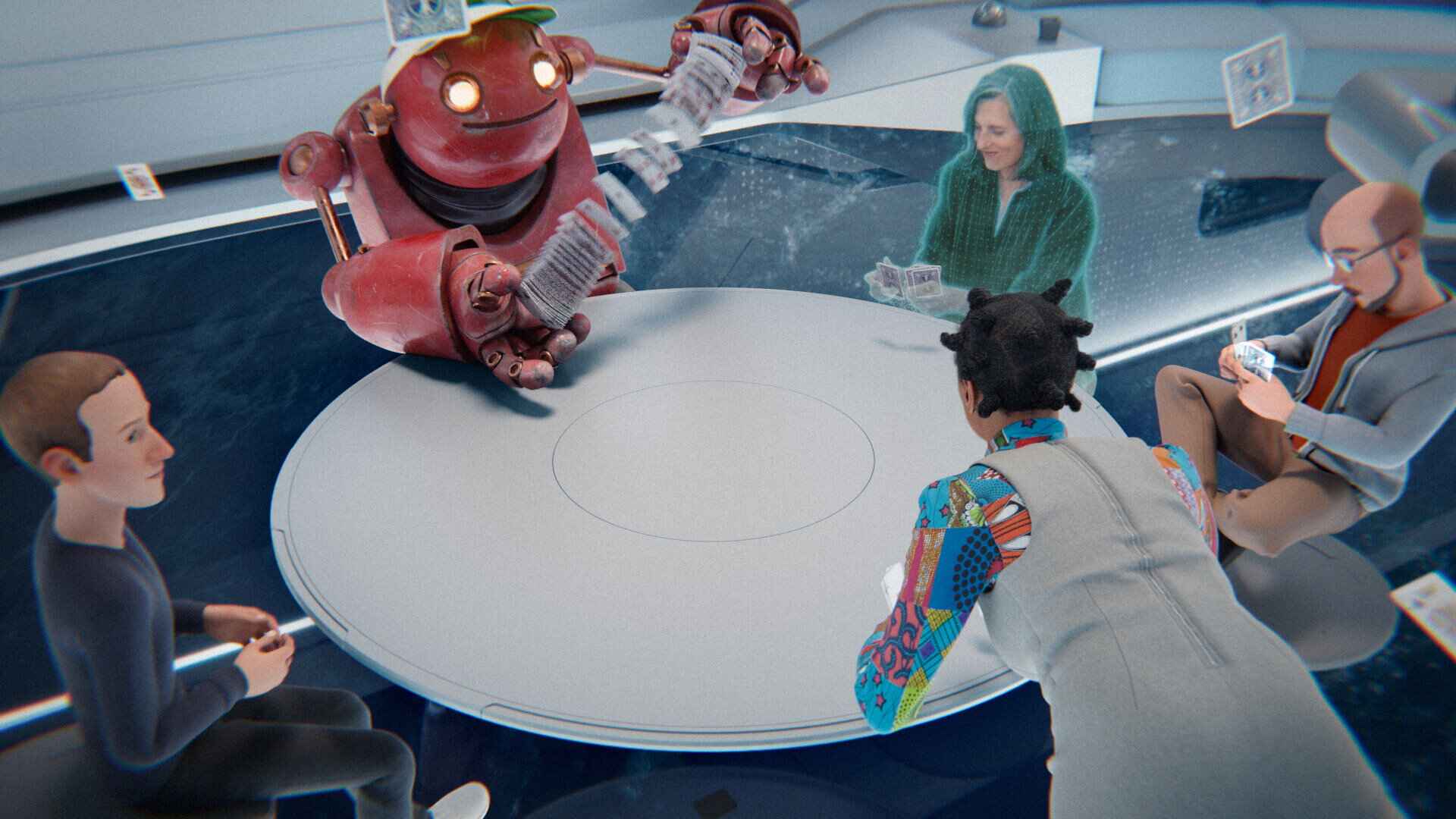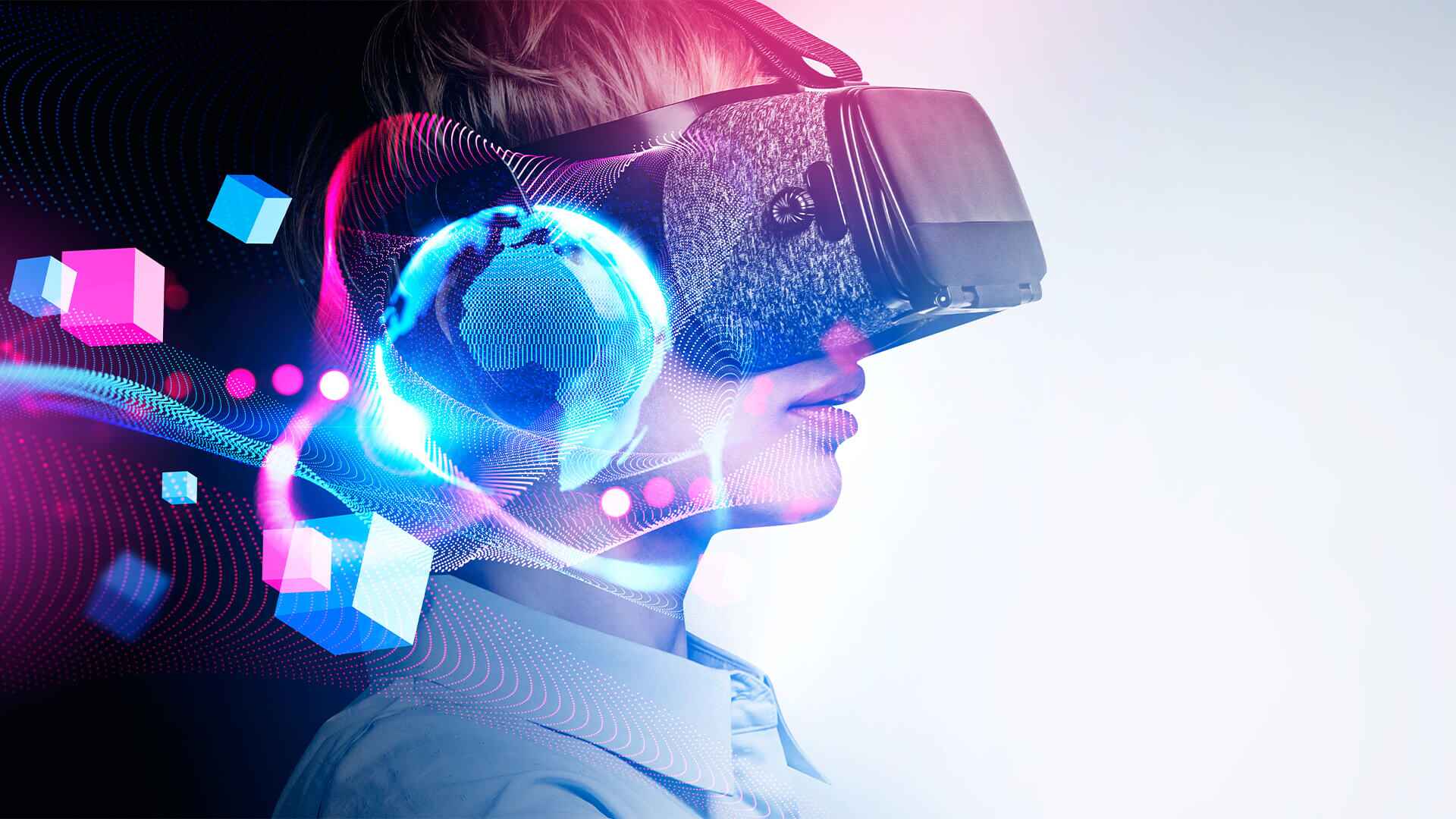Introduction
Welcome to the future of virtual reality: the Metaverse. In recent years, the concept of the Metaverse has gained significant attention, thanks to popular culture references and advancements in technology. This virtual realm, envisioned as a collective virtual shared space, allows users to explore, interact, and create experiences like never before. With its limitless potential, the Metaverse has captured the imagination of individuals and businesses alike.
But what exactly is the Metaverse? How does one go about creating their own virtual world within it? In this article, we will delve into the intricacies of building your own Metaverse and explore the necessary steps to bring it to life.
The idea of the Metaverse originated in science fiction literature, where authors envisioned a digital universe accessible through virtual reality. Today, visions of the Metaverse have become closer to reality, thanks to advancements in technologies such as virtual reality (VR), augmented reality (AR), and blockchain. These technologies are transforming the way we interact with digital spaces, pushing virtual experiences to new heights.
Creating your own Metaverse requires careful planning and execution. It involves designing and building a virtual world, implementing social interactions, creating avatars, incorporating realistic physics and mechanics, and even monetizing your virtual space. Each of these aspects plays a crucial role in shaping the overall user experience and determining the success of your Metaverse.
Whether you are an individual passionate about building your own digital universe or a business looking to leverage the Metaverse for marketing, education, or entertainment purposes, this article will guide you through the essential steps and considerations needed to make your Metaverse a reality.
So, fasten your seatbelts and get ready to embark on an exciting journey into the world of the Metaverse.
What is a Metaverse?
The concept of the Metaverse has gained significant attention in recent years, fueled by the advancements in technology and the growing interest in virtual reality. But what exactly is a Metaverse?
The Metaverse can be best described as a collective virtual shared space where users can interact, explore, and create experiences. It is a digital realm that brings together elements of virtual reality, augmented reality, and the blockchain to create a rich and immersive digital universe.
In the Metaverse, users can navigate through virtual worlds, interact with other users in real-time, and engage in various activities such as gaming, socializing, business transactions, education, and much more. It offers a vast landscape of possibilities, limited only by the imagination and creativity of its users.
Unlike traditional virtual reality experiences that are isolated and individual-centered, the Metaverse is a connected and collaborative space. It fosters social interactions and enables users to create shared experiences, blurring the line between the physical and digital worlds.
Within the Metaverse, users can create their own virtual worlds, known as instances, which can range from futuristic cities to fantasy realms to historical settings and beyond. These instances can be designed and customized to reflect the creator’s vision, offering unique experiences to visitors.
It is important to note that the Metaverse is not a single platform or application, but rather a concept that encompasses a network of interconnected virtual spaces and experiences. It is an expansive ecosystem comprising various platforms, technologies, and communities, all working together to form a unified virtual reality.
The potential of the Metaverse extends far beyond entertainment and gaming. It holds promise in areas such as education, healthcare, architecture, design, marketing, and more. Businesses are increasingly exploring the possibilities of leveraging the Metaverse to reach and engage with their target audience in innovative ways.
As technology continues to advance, the boundaries of the Metaverse will expand, offering even more immersive and realistic experiences. With the rise of virtual reality headsets, haptic feedback systems, and advancements in artificial intelligence, the Metaverse is poised to become an integral part of our digital future.
In the next sections, we will explore the fundamental aspects of building your own Metaverse, from preparing the infrastructure to developing virtual worlds, creating avatars, implementing social interactions, and monetizing the experience. So, let’s dive deeper into the exciting realm of the Metaverse and discover how you can bring your own digital universe to life.
Understanding the Concept
Before delving into the practical aspects of creating your own Metaverse, it is important to have a clear understanding of the underlying concepts and principles that drive this virtual realm.
At its core, the Metaverse is a convergence of multiple technologies and ideas that come together to form a seamless and immersive digital experience. Let’s explore some key elements that contribute to the concept of the Metaverse:
- Virtual Reality (VR): Virtual reality technology plays a pivotal role in the Metaverse, as it allows users to immerse themselves in a simulated digital environment. With the help of VR headsets, users can experience a sense of presence and interact with the virtual world in a more natural and intuitive way.
- Augmented Reality (AR): While virtual reality focuses on creating a fully immersive digital environment, augmented reality overlays digital elements onto the real world. In the context of the Metaverse, augmented reality can enhance the user experience by seamlessly blending digital content with the physical world, creating a mixed reality experience that engages users in new and exciting ways.
- Blockchain Technology: The integration of blockchain technology in the Metaverse brings transparency, security, and decentralization to virtual worlds. Utilizing blockchain technology, virtual assets and transactions within the Metaverse can be securely recorded and verified, enabling ownership, provenance, and traceability of digital assets.
- Interoperability: Interoperability is a crucial aspect of the Metaverse, allowing users to seamlessly navigate and interact across different virtual worlds and applications. A truly interconnected Metaverse ensures that experiences, assets, and identities can be transferred or shared between platforms, fostering a cohesive and unified virtual society.
- User-generated Content: The Metaverse empowers users to actively participate in content creation and customization. Users can shape their virtual environments, design avatars, create virtual objects, and even develop interactive experiences. This user-generated content fosters creativity and collaboration, making the Metaverse a constantly evolving and vibrant ecosystem.
With these elements in mind, it becomes evident that the Metaverse is not merely a single virtual space but rather a culmination of technologies and principles that enable the creation of a connected, immersive, and dynamic digital universe.
As you embark on the journey of building your own Metaverse, understanding these underlying concepts will guide you in making informed decisions and defining the unique characteristics of your virtual realm.
In the next sections, we will delve into the practical aspects of preparing the infrastructure, building the virtual world, creating avatars, implementing social interactions, and monetizing your Metaverse. Stay tuned to discover the key steps and considerations involved in bringing your vision to life within the Metaverse.
Preparing the Infrastructure
Building your own Metaverse requires a solid infrastructure that can support the virtual world and its users. Before diving into the development process, it is essential to lay the groundwork and ensure that you have the necessary tools and resources in place. Let’s explore the key steps involved in preparing the infrastructure for your Metaverse:
1. Hardware and Software: To create and experience the Metaverse, you will need the appropriate hardware and software. This includes powerful computers or servers capable of handling the computational requirements of running a virtual world. Additionally, you will need software tools or development environments specifically designed for building virtual worlds or utilizing existing Metaverse platforms.
2. Connectivity and Bandwidth: The Metaverse is a connected space, and thus, a reliable and high-speed internet connection is crucial. The seamless interaction between users, the transfer of data, and the real-time communication within the virtual world all rely on a stable and fast internet connection. Ensuring sufficient bandwidth and low latency will enhance the user experience within your Metaverse.
3. Scalability and Performance: As your Metaverse grows and attracts more users, it is important to consider scalability and performance. The infrastructure should be able to handle increasing user traffic, data storage requirements, and computational demands. Planning for scalability from the start will allow your Metaverse to accommodate a growing user base without sacrificing performance.
4. Security and Privacy: Protecting the virtual world and the users’ data is of utmost importance. Incorporate robust security measures to safeguard against cyber threats and protect users’ privacy. Implementing encryption, access controls, and authentication mechanisms are vital for creating a safe and secure environment within your Metaverse.
5. Cloud Services: Consider leveraging cloud computing services to augment your infrastructure. Cloud services provide scalable resources, reliable data storage, and computational power, offering flexibility and cost-effectiveness. They can be used for hosting your virtual world, managing data, and offloading computational tasks, allowing you to focus on the development and customization aspects of your Metaverse.
6. Collaborations and Partnerships: The Metaverse is a collaborative space, and forming partnerships and collaborations can broaden the scope of your virtual world. Consider partnering with technology providers, content creators, or even other Metaverse platforms to enhance the functionalities, content, and user experiences in your Metaverse.
By adequately preparing the infrastructure for your Metaverse, you set a solid foundation that supports the development, growth, and scalability of your virtual world. With these essential elements in place, you are now ready to embark on the exciting journey of building and customizing the virtual world within your Metaverse.
In the next section, we will dive into the process of building the virtual world, creating immersive environments, and populating your Metaverse with engaging experiences. Stay tuned!
Building the Virtual World
After laying the groundwork and preparing the infrastructure, it’s time to bring your Metaverse to life by building the virtual world. This is where the creative aspects of your vision come into play, as you design and develop immersive environments that users can explore and interact with. Let’s explore the key steps involved in building the virtual world of your Metaverse:
1. Define the Theme and Purpose: Begin by defining the theme and purpose of your Metaverse. Consider the type of experience you want to offer to users – whether it’s a futuristic sci-fi world, a fantasy realm, a historical setting, or something entirely unique. This theme will shape the visual aesthetics, narrative elements, and overall ambiance of your virtual world.
2. Conceptualize and Design: Utilize design tools or 3D modeling software to conceptualize the virtual world and create a blueprint. Plan the layout, structures, and landmarks within the world. Consider elements such as landscapes, architecture, terrain, objects, and interactive elements to enhance the immersive experience.
3. Implement 3D Graphics and Animation: Bring your virtual world to life by incorporating 3D graphics and animations. Use software tools or engage with 3D artists to create visually stunning landscapes, realistic avatars, and interactive objects. Pay attention to details, lighting, and textures to enhance the realism and visual appeal of your virtual world.
4. Scripting and Interactivity: Implement scripting or programming to introduce interactivity in your virtual world. This allows users to interact with objects, trigger events, and engage in activities within the virtual space. Incorporate game mechanics, puzzles, quests, or challenges to keep users engaged and make the experience more dynamic.
5. User-Friendly Navigation: Ensure that the virtual world is user-friendly and easy to navigate. Implement intuitive controls or gestures to enable smooth movement through the virtual environment. Provide clear signage or waypoints to guide users and prevent confusion. Allow users to teleport or travel between different areas of the virtual world efficiently.
6. Multiplayer Support: Configure your Metaverse to support multiplayer interactions, allowing users to connect and socialize with each other in real-time. Implement features like chat systems, voice communication, or gesture-based interactions to facilitate social interactions and enhance the collaborative aspect of your virtual world.
7. Test and Iteration: Conduct thorough testing to ensure the functionality and performance of your virtual world. Gather feedback from beta testers or early users and iterate on the design and features accordingly. Pay attention to user experience, responsiveness, and overall immersion to provide the best possible experience for your users.
Building the virtual world for your Metaverse requires a balance between creativity, technical expertise, and user experience considerations. By meticulously designing and implementing the virtual environment, you can create a captivating and immersive experience that keeps users coming back for more.
In the next section, we will explore the crucial step of creating and customizing avatars, allowing users to represent themselves within your Metaverse. Stay tuned as we dive into the fascinating world of digital identities!
Creating and Customizing Avatars
In the world of the Metaverse, avatars serve as the digital extensions of users, allowing them to visually represent themselves and interact within the virtual world. Creating and customizing avatars is a crucial step in providing users with a personalized and engaging experience. Let’s explore the key considerations and steps involved in creating and customizing avatars for your Metaverse:
1. Avatar Creation Tools: Choose or develop avatar creation tools that allow users to customize their appearance. Consider offering a wide range of options, including facial features, hairstyles, body types, clothing, accessories, and more. Provide sliders, selection menus, or intuitive interfaces that enable users to tailor their avatars to their liking.
2. Diversity and Inclusivity: Ensure that your avatar customization options are diverse and inclusive. Provide a wide range of skin tones, facial features, hair textures, and body shapes to reflect the diversity of your user base. Embrace a multicultural approach that allows users to create avatars that represent their unique identities.
3. Customization Depth: Strike a balance between simplicity and customization depth. While offering a variety of options is important, overwhelming users with too many choices can be counterproductive. Provide meaningful customization options that allow users to express their individuality without overwhelming them with unnecessary complexity.
4. Personalization Features: Consider adding personalization features that go beyond physical appearance. Allow users to select personalized characteristics such as voice, gestures, animations, or even unique abilities within the virtual world. This enables users to further express their personalities and stand out in the Metaverse.
5. Real-Time Mirroring: Implement real-time mirroring, where users can see their avatars and modifications in real-time as they make changes. This allows users to experiment with different customizations and immediately see the impact on their avatars, enhancing the sense of control and engagement.
6. User-Generated Content (UGC): Consider allowing users to create and share their own avatar assets within the Metaverse. Integrate UGC features that enable users to develop custom accessories, clothing items, or even unique avatar animations. This fosters user creativity and expands the customization options available in your virtual world.
7. Accessibility Considerations: Ensure that avatar customization is accessible to all users, regardless of their abilities. Implement features like adjustable font sizes, high contrast modes, or alternative input methods for users with disabilities. This inclusivity helps create a more inclusive and diverse virtual community.
Allowing users to create and customize their avatars provides a sense of ownership and self-expression within your Metaverse. By offering a robust avatar customization system that is inclusive, intuitive, and user-friendly, you empower users to become active participants in your digital universe.
In the next section, we will explore the crucial aspect of implementing social interactions within your Metaverse, enabling users to connect, collaborate, and engage with each other. Stay tuned for an exploration of the social dynamics within the Metaverse!
Implementing Social Interactions
One of the defining features of the Metaverse is the ability for users to interact and connect with others in real-time within the virtual world. Implementing social interactions is a crucial aspect of creating a vibrant and engaging community within your Metaverse. Let’s explore the key considerations and steps involved in implementing social interactions:
1. Communication Channels: Provide various communication channels that enable users to connect with each other. Implement features such as text chat, voice chat, or even video chat to facilitate real-time communication. These channels foster social interactions, collaboration, and the formation of virtual communities within your Metaverse.
2. Friendships and Connections: Enable users to establish connections and form friendships within the virtual world. Implement friend systems that allow users to send and accept friend requests, view online status, and easily access their friends’ profiles. This enhances the sense of community and encourages users to interact and collaborate.
3. Virtual Events and Gatherings: Organize virtual events and gatherings within your Metaverse to foster social interactions. These events can include concerts, conferences, social parties, or even gaming tournaments. Implement features such as event calendars, notifications, or dedicated event spaces to encourage users to participate and connect with each other.
4. Sharing and Collaboration: Facilitate easy sharing and collaboration between users. Implement features that allow users to share content, creations, or experiences with each other. This can include the ability to share screenshots, videos, or even custom creations within the virtual world. Encouraging collaboration and content sharing strengthens the sense of community within your Metaverse.
5. Social Spaces: Designate specific areas within your virtual world as social spaces where users can gather and interact. These spaces can include virtual cafes, parks, or community hubs. Implement features such as interactive games, group activities, or shared experiences within these social spaces to encourage users to engage and connect with each other.
6. Moderation and Safety: Incorporate moderation tools and safety features to ensure a positive and safe social environment within your Metaverse. Implement reporting systems, user blocking, or content moderation to address any issues or violations. It is essential to create a welcoming and respectful community that fosters positive social interactions.
7. Integration with Social Media: Consider integrating your Metaverse with existing social media platforms to enhance social interactions and connectivity. Implement features that allow users to link their Metaverse profiles with their social media accounts, share updates, or connect with friends from other platforms. This integration expands the reach of your virtual community and promotes cross-platform engagement.
By implementing robust social interaction features within your Metaverse, you create a vibrant and engaging virtual community. These features enable users to connect, collaborate, and form meaningful relationships within the digital realm, fostering a sense of belonging and exploration.
In the next section, we will explore the important aspect of adding realistic physics and mechanics to your Metaverse, creating a dynamic and immersive experience for your users. Stay tuned!
Adding Realistic Physics and Mechanics
To create a truly immersive and dynamic experience within your Metaverse, it is crucial to incorporate realistic physics and mechanics. Realistic physics and mechanics add depth and authenticity to the interactions and behaviors within the virtual world. Let’s explore the key considerations and steps involved in adding realistic physics and mechanics to your Metaverse:
1. Physics Engine: Integrate a physics engine into your virtual world to simulate realistic movement, collision detection, and object interactions. A physics engine computes the laws of physics, such as gravity, friction, and forces, to create a more lifelike and dynamic environment. Consider popular physics engines like Unity Physics or NVIDIA PhysX for a seamless integration.
2. Movement and Navigation: Implement realistic movement and navigation mechanics for avatars within the virtual world. This includes walking, running, jumping, and allowing users to interact with objects or surfaces. Consider factors like acceleration, deceleration, and momentum to create a sense of physicality and fluidity in avatar movement.
3. Object Interactions: Enable users to interact with objects in a realistic manner. Implement features like object manipulation, picking up and dropping objects, and physics-based interactions. Objects should respond to external forces, collisions, and constraints to provide a realistic and interactive experience for users.
4. Environmental Effects: Add environmental effects to create a more immersive experience. Consider incorporating features such as weather effects (rain, snow, wind), dynamic lighting, and realistic sound effects. These elements enhance the sense of realism and make the virtual world more engaging for users.
5. Procedural Generation: Utilize procedural generation techniques to create dynamic and realistic landscapes, terrains, or structures within the virtual world. Procedural generation algorithms can be used to generate realistic terrain, foliage, or even architecture, allowing for endless possibilities and adding depth to the virtual environment.
6. Simulated Interactions: Simulate realistic interactions between avatars and the virtual environment. This includes factors like avatar height affecting line of sight, collision detection with objects, and physics-based reactions to external forces. These simulated interactions contribute to a more immersive and believable experience within your Metaverse.
7. Gamification Elements: Consider incorporating gamification elements within your Metaverse to make the experience more interactive and engaging. This can include implementing quests, puzzles, or challenges that require users to leverage the physics and mechanics of the virtual world. Gamification elements add an extra layer of excitement and motivation for users to actively participate in the virtual space.
By incorporating realistic physics and mechanics into your Metaverse, you create a dynamic and immersive experience for your users. These elements contribute to a more interactive and authentic virtual world, elevating the overall user experience and making it feel more like a living, breathing environment.
In the next section, we will explore the crucial aspect of monetizing your Metaverse, allowing you to sustain and grow your virtual world. Stay tuned as we dive into the exciting world of virtual economies!
Monetizing the Metaverse
An important aspect of creating and maintaining a successful Metaverse is the ability to monetize it effectively. Monetization not only helps sustain the virtual world but also allows you to invest in its growth and provide enhanced experiences for your users. Let’s explore the key considerations and strategies for monetizing your Metaverse:
1. Virtual Currency: Implement a virtual currency system within your Metaverse. Users can acquire this virtual currency through in-app purchases, completing quests, or participating in virtual economy activities. The virtual currency can then be used to purchase virtual goods, cosmetics, or access premium features within the virtual world.
2. Virtual Goods and Cosmetics: Offer a wide range of virtual goods, accessories, clothing, or other cosmetic items that users can purchase to personalize their avatars and enhance their virtual experience. These virtual items can be sold directly through in-app purchases or even through virtual auctions or marketplaces within your Metaverse.
3. Land and Property Sales: Introduce virtual land or property sales, allowing users to own and develop their virtual spaces within your Metaverse. Users can purchase plots of land or properties and customize them with buildings, decorations, or interactive elements. This creates a virtual real estate market and provides users with investment opportunities within the virtual world.
4. Subscription Models: Offer subscription plans that provide users with access to exclusive content, services, or features. Subscriptions can be offered on a monthly or yearly basis and can include benefits such as early access to updates, premium support, or exclusive events. Subscription models provide a recurring revenue stream and foster user loyalty.
5. Sponsorships and Partnerships: Collaborate with brands or organizations for sponsorships and partnerships within your Metaverse. This can involve featuring branded content, hosting sponsored events, or offering virtual experiences tied to specific brands or products. Sponsorships and partnerships can provide a significant revenue stream while enhancing the overall user experience in your virtual world.
6. Advertising and Promotions: Incorporate targeted advertising or promotional opportunities within the virtual world. This can include branded billboards or in-game advertisements that users can interact with. Carefully integrate these advertisements to ensure they align with the overall aesthetics and experience of your Metaverse.
7. User-Generated Content Marketplace: Enable users to create and sell their own virtual assets, creations, or experiences within your Metaverse. Implement a user-generated content marketplace where users can showcase and sell their creations to other users. This fosters a vibrant creator community and provides additional revenue streams for both users and your Metaverse.
By implementing effective monetization strategies, you can generate revenue and sustain the growth of your Metaverse. Balancing user experience, value proposition, and revenue generation will help create a profitable ecosystem while ensuring the engagement and satisfaction of your users.
In the final section, we will explore the important steps involved in maintaining and updating your Metaverse, ensuring its longevity and continuous evolution. Stay tuned for insights on keeping your virtual world thriving!
Maintaining and Updating Your Metaverse
Maintaining and updating your Metaverse is crucial to ensure its longevity, relevance, and continuous growth. Regular maintenance and updates keep the virtual world fresh, engaging, and free from technical issues. Let’s explore the key steps involved in maintaining and updating your Metaverse:
1. Bug Fixes and Performance Optimization: Regularly monitor and address any technical issues or bugs that may arise within your Metaverse. Continuously optimize performance to ensure smooth gameplay, seamless interactions, and minimal latency. Promptly addressing technical issues enhances the user experience and maintains the credibility of your virtual world.
2. Content Updates: Keep your virtual world fresh and exciting by regularly adding new content. This can include introducing new areas, quests, challenges, or virtual events for users to explore and participate in. Regular content updates keep users engaged, encourage them to revisit the Metaverse, and attract new users.
3. User Feedback and Community Engagement: Actively engage with your user community and gather feedback to understand their needs, preferences, and pain points. Regularly communicate with your users through forums, surveys, or social media channels. Listen to their feedback and incorporate valuable suggestions into future updates and enhancements.
4. Security and Privacy: Stay vigilant and ensure the security and privacy of your users’ data within the Metaverse. Regularly update security measures, implement encryption protocols, and address any potential vulnerabilities. Prioritize the privacy and safety of your users to maintain their trust and confidence in your virtual world.
5. Community Management: Foster a positive and engaging community within your Metaverse by actively moderating user interactions and ensuring respectful behavior. Address any inappropriate or harmful conduct promptly to maintain a welcoming and inclusive environment. Encourage positive discussions, events, and collaborations among users to enhance community engagement.
6. Technological Advancements: Stay updated with the latest technological advancements to ensure your Metaverse remains relevant and competitive. Embrace emerging technologies, such as virtual reality hardware improvements or augmented reality integrations, to enhance the immersive experience within your virtual world. Continuously explore new possibilities and leverage advancements to stay at the forefront of the Metaverse landscape.
7. User Support and Communication: Provide reliable user support and maintain open lines of communication with your user community. Establish responsive customer support channels and promptly address user inquiries or concerns. Clear and consistent communication demonstrates your commitment to the user experience and fosters trust and loyalty within your Metaverse.
By actively maintaining and updating your Metaverse, you ensure its continued relevance, growth, and user satisfaction. Regular bug fixes, content updates, community engagement, and technological advancements contribute to a dynamic and thriving virtual world that keeps users coming back for more.
With this, we conclude our exploration of the crucial steps involved in building, managing, and monetizing your own Metaverse. By following these guidelines and embracing the potential of the Metaverse, you can create a captivating and immersive digital universe that delights and connects users from all corners of the world.
Conclusion
Congratulations! You have now learned the essential steps involved in building, maintaining, and monetizing your own Metaverse. By understanding the concept of the Metaverse and preparing the infrastructure, you lay the foundation for creating a dynamic and immersive virtual world. Building the virtual world itself allows you to unleash your creativity and design captivating environments for users to explore. Customizing avatars and implementing social interactions enhance the sense of community and connection within your Metaverse.
Add realistic physics and mechanics to create an engaging and immersive experience, and explore various monetization strategies to sustain and grow your virtual world. By regularly maintaining and updating your Metaverse, you ensure its longevity, relevance, and user satisfaction.
The Metaverse represents a boundless realm of possibilities. It offers incredible opportunities for individuals and businesses to connect, create, learn, and explore, all within a virtual environment that mimics the real world or transcends it in exciting ways. As technology continues to advance and our collective imagination expands, the Metaverse will evolve and revolutionize the way we interact with digital spaces.
So, take these learnings and ideas, infuse them with your own creativity, and embark on the incredible journey of building your own Metaverse. Embrace the potential, push the boundaries, and discover the limitless possibilities that await you in this virtual frontier.
Now, go forth and create your digital universe – a Metaverse that captivates, connects, and inspires!

























